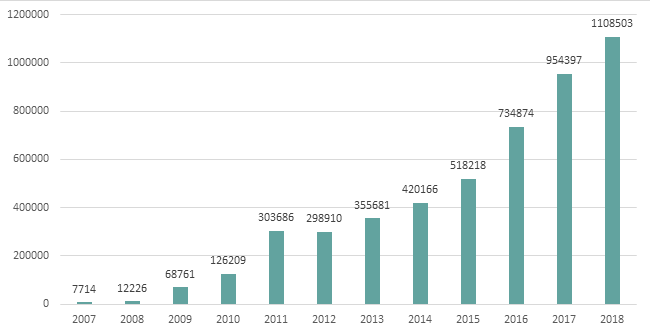Resume: In 2018, the territories of the Algeti National Park and the Kazbegi National Park as well as the Tusheti, Batsara-Babaneuri, Lagodekhi and Vashlovani protected areas were expanded. As a result, the territory of protected areas increased by 1% as compared to 2017 and reached 665,664 hectares which constitutes 9.55% of Georgia’s whole territory.
The number of visitors to the protected areas increased by 16% as compared to 2017 and reached 1,108,503 persons. Of this amount, 579,480 were Georgian nationals whilst 529,023 were foreign visitors.
In 2018, the eco-tourist and eco-education infrastructure was also renovated and rehabilitated (infrastructure of a mastic tree education path as well as infrastructure for the Satsurblia and Navenakhevi caves and the Martvili canyon were renovated, the infrastructure of the Okatse canyon was rehabilitated and the infrastructure for the Okatse (Kinchkha) waterfall was installed). Revenues received as a result of the development of eco-tourism services amounted to GEL 8,436,125 in 2018 which is 87% more as compared to 2017 figure (GEL 4,504,473).
Analysis
In his speech at the plenary session of the Parliament of Georgia, the Minister of Environment Protection and Agriculture of Georgia, Levan Davitashvili, stated: “In 2018, the area of protected territories increased by 1% and reached 9.5%; that is, nearly 667,000 hectares. The number of visitors to the protected territories increased by 16%. Of important note is that together with the development of infrastructure and improved services, we managed to increase incomes from the eco-tourism services of protected areas by 87%.”
FactCheck took interest in the accuracy of the statement.
As the 2018 report of the Agency of Protected Areas of Georgia is not yet publicly available, FactCheck addressed the Agency of Protected Areas with questions in regard to the statistical information presented in Levan Davitashvili’s statement. The Agency’s letter of reply reads that the territories of the Algeti National Park and the Kazbegi National Park as well as the Tusheti, Batsara-Babaneuri, Lagodekhi and Vashlovani protected areas were expanded in 2018. As a result, the territory of the protected areas increased by 1% as compared to 2017 and reached 665,664 hectares which constitute 9.55% of Georgia’s whole territory.
In regard to the number of visitors, the total amount of visitors to protected areas in 2018 reached 1,108,503. Of this amount, 579,480 were Georgian nationals and 529,023 were foreigners. In 2017, the total number of visitors was 954,397. Of this amount 57% (541,634) were Georgians and 43% (412,763) foreigners. Therefore, the number of visitors to the protected territories increased by 16% in 2018 as compared to 2017. Of note is that since 2007, the number of visitors to Georgia’s protected territories has been rising significantly every year (2012 being the only exception when number of visitors dropped).
Graph 1: Number of Visitors to Georgia’s Protected Areas, 2001-2018

Source: Agency of Protected Areas
In 2018, different kinds of infrastructure were installed in the protected areas. In particular, protection infrastructure was put in place in the Tbilisi, Machakhela and Borjom-Kharagauli national parks, road signs were produced for the administrations of 15 protected areas and the demarcation of 79,908 hectares was carried out for the Pshav-Khevsureti national park as a part of the Agency and KFW/GFA’s cooperation. In addition, the following eco-tourism and environmental education information infrastructure was installed and rehabilitated: infrastructure of a mastic tree education path as well as the infrastructures of the Satsurblia and the Navenakhevi caves and the Martvili canyon were renovated, the infrastructure of the Okatse canyon was rehabilitated and the infrastructure for the Okatse (Kinchkha) waterfall was installed. Revenues received as a result of the development of eco-tourism services amounted to GEL 8,436,125 in 2018 which is 87% more as compared to 2017 figure (GEL 4,504,473).

















